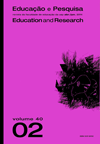Graduates in Portugal: a typification of professional transition profiles
DOI:
https://doi.org/10.1590/S1517-97022014005000001Abstract
Adequacy of educational background to professional situation is a subject that emerges whenever the theme of graduates' professional transition is approached. This paper intends to analyze the professional situations of Portuguese higher education degree holders five years after they attained their degree, in light of questions related to professional transition. We examine the relationship between the educational system and the labor market by comparing international indicators that serve as a context for the Portuguese case, in order to discuss the empirical results that characterize the professional situation experienced in 2010 by a sample of 1,004 higher education degree holders from two Portuguese universities. Five types of professional situation are defined based on multivariate analysis techniques and then reflected on the profiles found. We concluded that the majority of graduates perform professional activities that are adequate for their education level, with earnings, employment contracts and work hours as well as to those of the specialists in intellectual and scientific activities group. However, a more refined analysis reveals a hierarchical arrangement of professional situations in a continuum ranging from fragile to qualifying professional transition, associated with graduates study field. Education, Arts and Humanities degree holders are in the most precarious labor situations, in contrast with an over-representation of Health, Finance, Management and Law degree holders in the most favorable jobs.Downloads
Download data is not yet available.
Downloads
Published
2014-06-01
Issue
Section
Articles
License
Authors assume exclusive responsibility for the concepts expressed in their articles, which do not necessarily reflect the journal’s opinion.
Permission to photocopy all or part of the material published in the journal is granted provided that the original source of publication be assigned.
How to Cite
Graduates in Portugal: a typification of professional transition profiles . (2014). Educação E Pesquisa, 40(2), 383-400. https://doi.org/10.1590/S1517-97022014005000001



